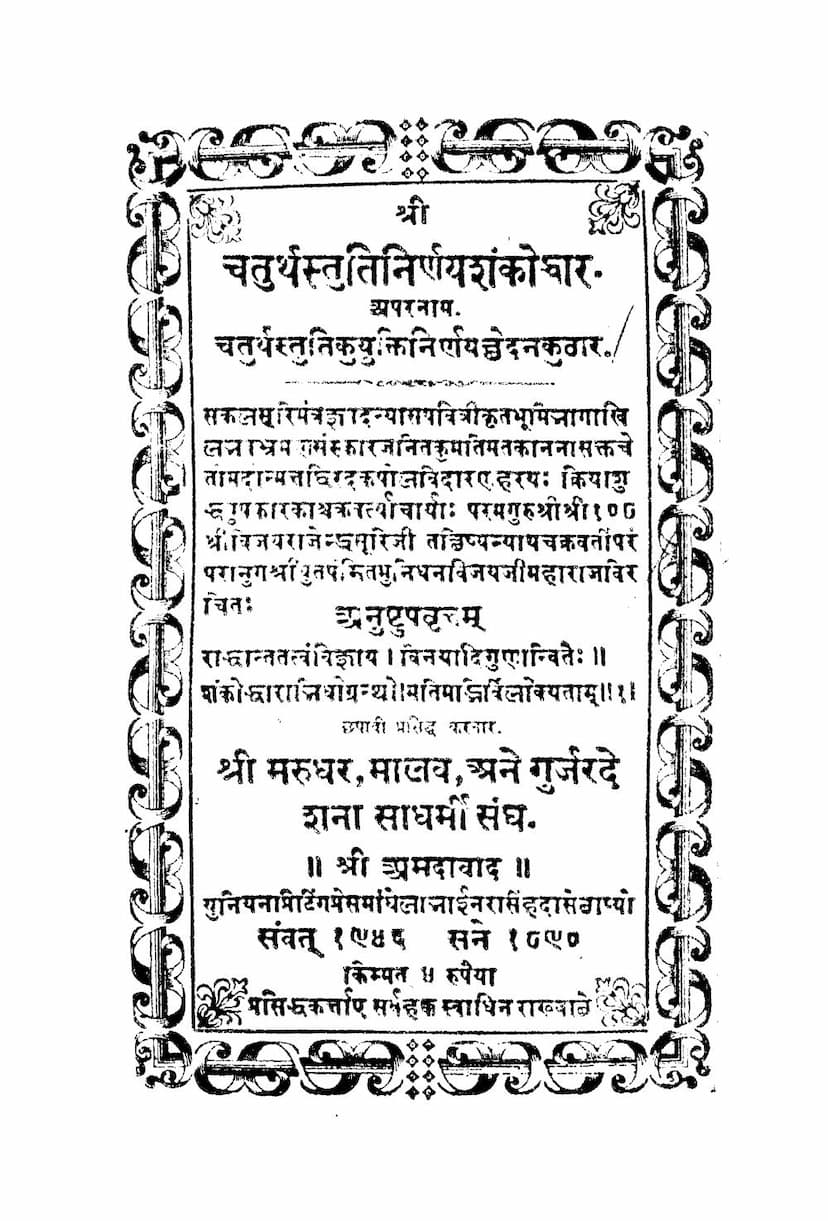Chaturth Stuti Nirnay Shankoddhara
Added to library: September 1, 2025

Summary
This book, "Chaturth Stuti Nirnay Shankoddhara" (also known as "Chaturth Stuti Kuyukti Nirnay Chhedan Kuthara"), authored by Marudhar Malav and Gurjar Deshna Sadharmik Sangh, and published by the same, is a significant Jain text. The catalog link provided is https://jainqq.org/explore/010841/1.
This comprehensive work is a detailed critique and refutation of the views presented by Muni Atmaram and Anandvijayji, particularly concerning the practice of "Chaturth Stuti" (Fourth Praise) within Jain rituals, specifically during the Paryushan festival. The text, compiled by the Sadharmik Sanghs of Marudhar, Malwa, and Gurjar Desh, aims to clarify and correct what they perceive as erroneous interpretations and practices introduced by Atmaram.
Key themes and content of the book, as revealed through the provided pages, include:
- Dispute over "Chaturth Stuti": The central theme revolves around a theological debate regarding the practice of offering a "Fourth Praise" during specific Jain rituals, particularly in the context of Chaitya Vandan (worship of temples/idols). Atmaram is accused of introducing this practice without proper scriptural basis.
- Allegations against Atmaram: The text details several accusations against Muni Atmaram, including:
- Making "out-of-rule" statements (उत्सूत्र जाप).
- Breaching his word.
- Displaying arrogance and ego.
- Engaging in debates with other scholars, such as Muni Dhanvijayji (a disciple of Acharya Vijayrajendrasuriji), but refusing to engage in substantive discussions on scriptures.
- Misrepresenting facts and spreading falsehoods in publications like the "Amadabad Samachar."
- Criticizing and misrepresenting the teachings and practices of respected Jain monks, specifically Acharya Vijayrajendrasuriji and Muni Dhanvijayji.
- Misinterpreting and misrepresenting various Jain scriptures, including the "Panchangi" and other texts, to support his controversial views.
- Defense of Traditional Practices: The book strongly defends the traditional Jain practices and interpretations, highlighting the authority and validity of the teachings of the "Purvacharyas" (ancient Jain monks) and the "Agamas" (Jain scriptures).
- Role of Acharya Vijayrajendrasuriji and Muni Dhanvijayji: The text positions Acharya Vijayrajendrasuriji and Muni Dhanvijayji as the upholders of correct Jain doctrine, whose practices and teachings are being misrepresented by Atmaram. The book details instances where they attempted to clarify matters with Atmaram, but he allegedly refused to engage in proper scriptural discourse.
- Scriptural Interpretation and Debate: A significant portion of the text is dedicated to a detailed analysis and interpretation of various Jain scriptures to refute Atmaram's claims. The authors meticulously quote scriptural passages and provide their explanations to demonstrate the correctness of their stance and the alleged errors in Atmaram's interpretations. This includes discussions on the validity of different types of "Agamas" (Sutragama, Arthagama, Tadanayagama) and the process of "Upasamprada" (initiation/ordination).
- Grammatical and Orthographical Criticisms: The text also points out what it considers to be grammatical and orthographical errors (like the incorrect use of long and short vowels) in Atmaram's writings, suggesting a lack of meticulousness or understanding of the scriptures.
- Invitation for Debate and Resolution: The authors express their willingness to engage in a proper debate or discussion on these matters, suggesting a process of resolving scriptural disputes through established scholarly means, rather than through unilateral pronouncements.
- Specific Texts Discussed: Several Jain texts are referenced and analyzed, including:
- Panchangi: A fundamental scriptural authority.
- Sutragama, Arthagama, Tadanayagama: Different categories of scriptural knowledge.
- Uttaradhyayan Sutra: A key Jain scripture.
- Mahavakyas and Niyukti: Important Jain commentaries and foundational texts.
- Panchashataka, Vrundaru Vritti, Laghu Napyas: Works by prominent Acharyas.
- Nisiht Sutra, Avashyak Sutra, and their commentaries (Vritti, Churni, Niyukti): Essential texts for understanding Jain monastic conduct and rituals.
- Jivannigama Sutra, Rahasyapradipika: Texts related to Jain philosophy and cosmology.
- Jain Tattvadarshan: A text by Atmaram.
- Vachanamrita: A publication that Atmaram allegedly used to spread misinformation.
Overall Purpose: The primary aim of "Chaturth Stuti Nirnay Shankoddhara" is to uphold the sanctity of Jain scriptures, defend the traditional practices of the faith, and correct what the authors believe to be misinterpretations by Muni Atmaram. The book serves as a defense of established Jain orthodoxy against what it perceives as heterodoxical interpretations, fostering a call for adherence to scriptural authority and established tradition. The extensive referencing of scriptures and detailed refutations suggest a scholarly and earnest attempt to maintain doctrinal purity within the Jain community.